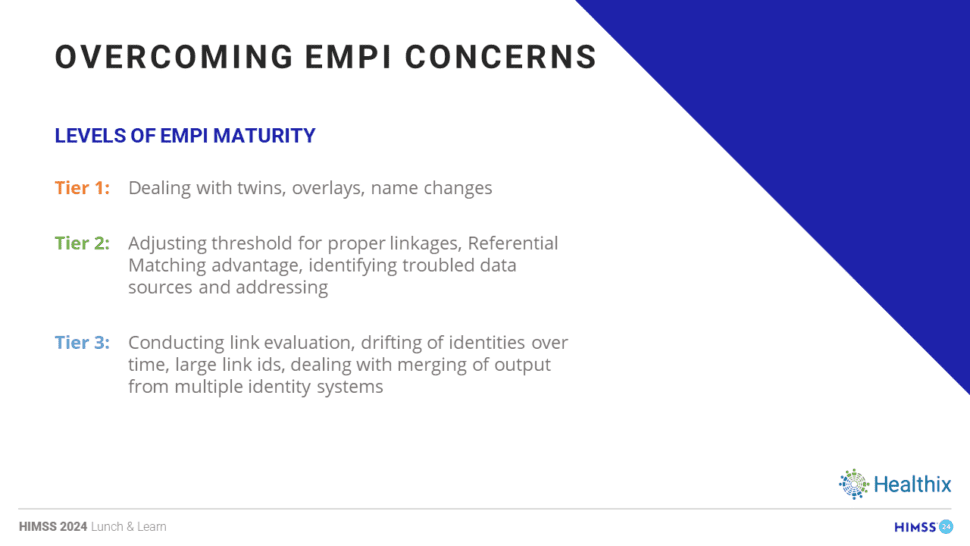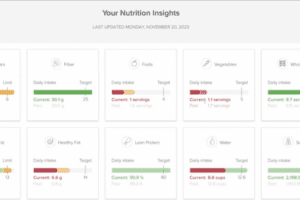The government and many healthcare leaders are pushing for more interoperability and data sharing in healthcare. While this is great and has the potential to make a really big impact for good on the lives of patients and potentially costs, one thing that is often missed in this discussion is high quality patient identification. This is a problem that’s made worse by not having a national patient identifier, but let’s set that topic aside for a moment and recognize that even with a national patient identifier, patient identification and patient matching is still going to be a massive challenge.
The depth of this challenge and some modern solutions for managing identities in healthcare was illustrated really well in a session at the HIMSS 2024 conference by Todd M. Rogow, CEO and President at Healthix, who shared their use of Verato to address their Patient Identity challenges. Check out our summary of the session below along with some added commentary. Plus, be sure to check out the slide that illustrates the various levels of EMPI (Enterprise Master Patient Index) maturity.
First up was an intro to Healthix, one of the largest public HIEs out there that serves New York.
When you look at how much data is passing through Healthix, it’s kind of hard to comprehend. 50 million patients with 105+ million inbound data is a lot of health data. Plus, I love to see that they’ve sent 15+ million alerts that help healthcare organizations better coordinate care.
It’s always interesting to see how an HIE is approaching their exchange of data. The use cases vary across HIEs since their funding often determines what they choose to focus on. Although Healthix has a pretty broad range of areas they impact with their exchange of data. No doubt, HIEs have become critical and provide an important service to their communities that improves healthcare quality by enabling providers, public health, research and other stakeholders with better access to patient information.
Of course, one of the biggest problems they faced was how do you handle identity across all of these various sources, functions, and services? Rogow illustrated really well in the following slide how people think that identity goes across the wide spectrum of patient engagements that occur.


While many think that identity is simple like that, the reality is very different because many of these points of engagement with patients are happening across a wide variety of different systems as is shown below.


Then he shared the money slide which illustrates how the flow of patient data actually happens in healthcare. It’s no wonder that identity management is so challenging and why you need a thoughtful approach to EMPI to make the exchange of health data work effectively.


Rogow and Healthix decided to partner with Verato for their EMPI to be able to reduce their manual data tasks and to address the 16 million patients with millions of potential matches that needed manual resolution. They were able to go live with Verato in 6 weeks as they worked through 100,000 tasks per day. 4 months later they saw a reduction of 3.5 million patient identities in their EMPI.
Rogow also highlighted how one of the keys to their success was having a comprehensive end-to-end approach for patient identity that was purpose built for healthcare. Healthix accomplished this by migrating from the Verato EMPI solution to the Verato hMDM solution. Below you can find some of the key areas an all in one platform needs to include.
Plus, he shared a more detailed slide that shares some of the complexity of the above areas that has to be addressed to create a holistic approach to master data management.
However, my favorite slide was this look at a kind of EMPI maturity model if you will. Rogow shared 3 tiers or levels of EMPI maturity that you go through as you improve patient identity in your organization. EMPI is an ongoing effort that starts with a lot of the low hanging fruit and then deals with the harder patient identity problems as you mature. This slide illustrates details of how that matures over time.


Finally, Rogow highlighted a great quote that says “The best technologies are the ones that you stop noticing. – Chris Thorn” One of the beauties of well done EMPI is that the technology can disappear into the background and make the journey extremely easy for the user so that it feels like magic.
Doing patient identity well is a lot of hard work and is full of challenging situations that have to be dealt with effectively. However, for all of this data that’s being shared to be useful to those getting the data, effective patient identification and patient matching is essential. Otherwise, you’re sharing a bunch of data that nobody is going to trust.
Thanks to Rogow from Healthix for sharing their patient identity journey with Verato. There are a lot of lessons here for those who are dealing with patient identity.













Add Comment